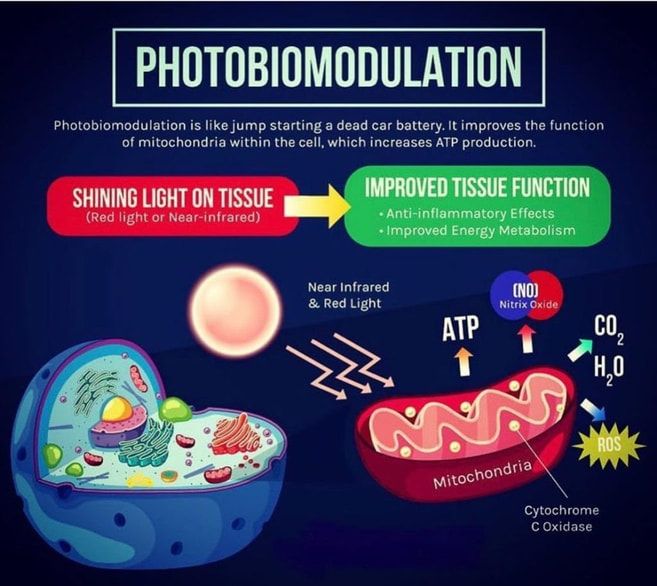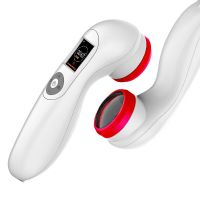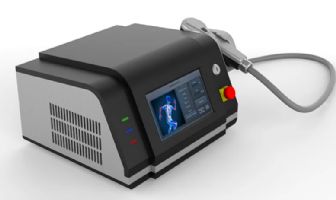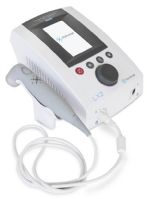 Written by Dr. Eric Wood, ND, MA
Written by Dr. Eric Wood, ND, MA
If you are experiencing stubborn pain and inflammation that you just can’t seem to get rid of from either a chronic condition or an acute injury, you may want to try cold laser therapy. Different from lasers used for surgical interventions, cold lasers are not actually cold - this just describes their low level of photon production. Safe, fast, and non-invasive, cold laser therapy delivers analgesic, anti-inflammatory, and regenerative healing at the cellular level. We invite you to read on to learn more about how this popular and proven photobiomodulation therapy can help you.
.jpg)
Encompassing the visible and near-infrared spectrum of light, photobiomodulation therapy (PBMT) uses non-ionizing forms of light sources like cold lasers, LEDs, and broadband light to treat pain, inflammation, and many other medical conditions. Also known as low-level laser therapy (LLLT), biostimulation, cold laser therapy, and soft laser therapy, PBMT applies light at wavelengths ranging from 400 to 1,100 nm. Lower wavelengths are used for topical and subcutaneous health issues, while higher wavelengths penetrate more deeply to address unfavorable conditions occurring in the muscles, soft tissues, and bones. Triggering photochemical changes at the cellular level, our mitochondria are especially receptive to this photonic energy, absorbing the light to produce cellular energy called ATP (adenosine triphosphate), which facilitates health and well-being.

The wavelengths of light used for cold laser therapy technically range between 600 to 1070 nm, with shorter wavelengths between 600 to 700 nm optimizing treatment for superficial tissues and longer wavelengths between 780 to 950 nm penetrating further for treating deeper tissues. Cold laser therapy isn’t actually cold - this term simply refers to the lower levels of the light delivered for therapy as opposed to the higher light wavelengths of the very strong lasers used in surgery. Cold laser therapy includes red light therapy to treat more topical conditions and near-infrared light therapy to treat deeper conditions. Although this non-thermal therapy does include coherent light sources such as low-level lasers, it can also be delivered via non-coherent LEDs or filtered lamps. Some devices may combine both lasers and LEDs or offer both red light and near-infrared light wavelengths to customize therapy and optimize results.
 | LOTUXS PowerCure Pro Handheld Cold Laser Therapy Device View Product |
Cold laser therapy is delivered with a small handheld device that’s placed directly on or above the affected area of the body. Penetrating the skin and underlying tissues, the light photons generated by the device are absorbed by the body, promoting healthier cellular activity that results in muscle relaxation, decreased inflammation, pain relief, and tissue regeneration. Whether it is performed by a healthcare professional or at home, cold laser therapy procedures are painless and non-invasive, with no sound or vibrations, or any hot or cold sensations. For optimal results, cold laser therapy is typically used multiple times a week for several weeks.
 | Lotuxs Laser Therapy Device View Product |
Proven effective and cleared by the FDA (US Food and Drug Administration) to treat a variety of conditions, cold laser therapy provides a safe and non-invasive healing modality for people of all ages. Although you may need multiple sessions before treatment goals are realized, these sessions only take a few minutes, making it easy for you to work this therapy into your schedule. Easy to apply to the affected body area, cold laser therapy treatments are completely painless. Smaller handheld units are also conveniently portable, ensuring easy transport of the device so you can enjoy therapy wherever you go. Offering efficacious non-pharmacological relief, cold laser therapy does not have any known side effects when it is used correctly.
 | TheraTouch LX2 Cold Laser Therapy Device View Product |
Used by a variety of medical professionals including doctors, physical therapists, dentists, and chiropractors, cold laser therapy can help with a number of different medical conditions. While the FDA has cleared its use for expediting wound healing and tissue repair, relieving inflammation and pain, along with boosting circulation, there is much ongoing research to explore the efficacy and safety of cold laser therapy in treating major medical issues, including Opioid Use Disorder (OUD), traumatic brain injury (TBI), Parkinson’s disease, spinal cord injury, Alzheimer’s disease, and COVID-19.
Gently penetrating the body’s tissues with light photons, cold laser therapy enhances our own regenerative abilities to reduce inflammation. Ideal for reducing the inflammation involved in both osteoarthritis and rheumatoid arthritis, cold laser therapy has proven to be efficient in modulating the inflammatory mediators and inflammatory cells that contribute to overall inflammation from both chronic and acute medical conditions. This therapy has even been demonstrated to reduce lung inflammation along with mitigating chronic inflammation of the airways, making it a viable tool in the treatment of chronic pulmonary allergic inflammation associated with asthma.
As the most common reason for consulting a physician in the US, pain affects 1 out of 3 Americans annually. For over 40 years, cold laser therapy has been shown to induce analgesic effects, along with reducing inflammation and swelling. Utilized for both chronic and acute pain, cold laser therapy is indicated for fibromyalgia, carpal tunnel syndrome, joint disorders, neck pain, plantar fasciitis, frozen shoulder, neuropathy, sprains, knee pain, strains, post-operative pain, tendonitis, bursitis, back pain, epicondylitis, fractures, muscle spasms, TMJ, and exercise-induced muscle fatigue/pain.
Numerous studies have demonstrated how effective cold laser therapy is for speeding the healing of wounds and tissue regeneration. Often used to treat diabetic foot ulcers, this low-level light therapy augments the body’s natural healing process, promoting the formation of granulation tissues and cell proliferation. It enhances the escalation of fibroblast production along with increased collagen synthesis, making it an ideal therapy for healing wounds of all kinds, including decubitus (pressure) ulcers. Cold laser therapy is the modality of choice for healing stubborn, hard-to-heal wounds, including third-degree burns.
Proven to increase blood flow in the body’s soft tissues, cold laser therapy encourages healthy blood circulation, enhancing nutrient and oxygen delivery to various areas of the body. Inducing arteriolar vasodilation that quickly increases tissue perfusion and capillary flow, this healthy effect is also long-lasting. Cold laser therapy is an effective treatment for impaired blood flow and tissue ischemia that’s often related to peripheral artery disease (PAD). Improved circulation helps to activate lymphatic drainage, removing toxins and reducing swelling.
Although cold laser therapy is considered to be a very safe and non-invasive healing modality, there are some contraindications for people living with cancer or epilepsy or those who are pregnant. It should not be used directly on the thyroid gland or the eyes, nor directly over a bacterial infection. The cold laser therapy device should never be used directly over cochlear implants, pacemakers, and other internal electronics, nor should it be used directly over a port. People on immunosuppressive therapy may also need to avoid this therapy, as the light photons may boost the immune system. Be sure to consult with your doctor before starting any type of new therapy, including cold laser therapy.
If you’re getting cold laser therapy treatments at a clinic or doctor’s office, the average national charge for one session can cost anywhere between $50 to $150+, with possible discounts for bundled treatment packages. Acute conditions may need to be treated daily, while chronic conditions typically require 2 or 3 sessions per week. This therapy is not covered by Medicare or Medicaid and because it is still considered experimental, many other insurance providers won’t cover it as well. Because these fees add up pretty quickly, you can see how owning your own cold laser therapy device to use at home would save a ton of money in the long run. Ranging from a few hundred dollars to a few thousand dollars, they are the most affordable treatment option if you plan on using this therapy long-term.

Cold laser therapy, now more formally known as photobiomodulation therapy (PBMT), is an effective therapeutic modality that’s been proven to relieve pain, reduce inflammation, increase blood flow, and speed up cellular processes to optimize healing. Non-invasive, non-pharmaceutical, and generally safe for most people, cold laser therapy uses low-level lasers or LEDs to emit wavelengths of light photons in the visible red and non-visible near-infrared range to help you reach your healing goals.
This unique therapy is offered by a range of various medical professionals, or you can save a lot of money and time by purchasing your own device to use at home or wherever you roam. We invite you to peruse our comprehensive selection of cold laser therapy devices for more options and be sure to check out our Caregiver University blog to read more educational articles that can help you and your loved ones optimize your health and wellness.

Dr. Wood is a licensed naturopathic doctor in Washington D.C. and founder of Visionary Health. A graduate of the Canadian College of Naturopathic Medicine, Dr. Wood is a professor at John Patrick University in the Integrative and Functional Medicine Department as well as an adjunct professor at the American College of Healthcare Sciences in Holistic Nutrition. He began his career as a specialty physician for two leading supplement US companies, Neuroscience Inc. and Life Extension. Over his fifteen-year career in integrative and holistic medicine, he has worked in diverse capacities including as an educator; writer; medical advisor, consultant and formulator for supplement companies and treatment centers in the US and the EU; public speaker; and clinician. He has long been a practicing advocate of lifestyle medicine, fitness and mind body medicine approaches initially spurred by aging family members not getting help from traditional medicine and is passionate about innovating and bringing natural and integrative medicine to the masses!